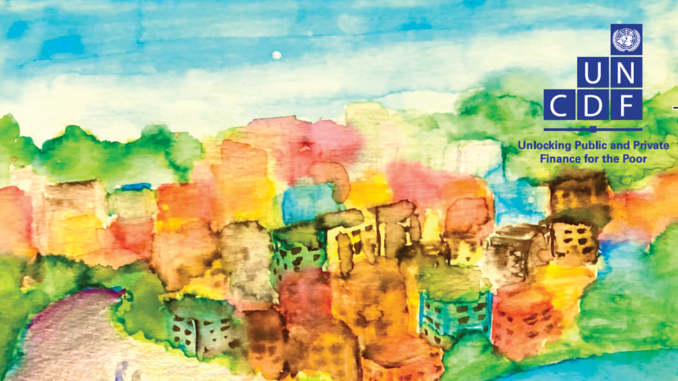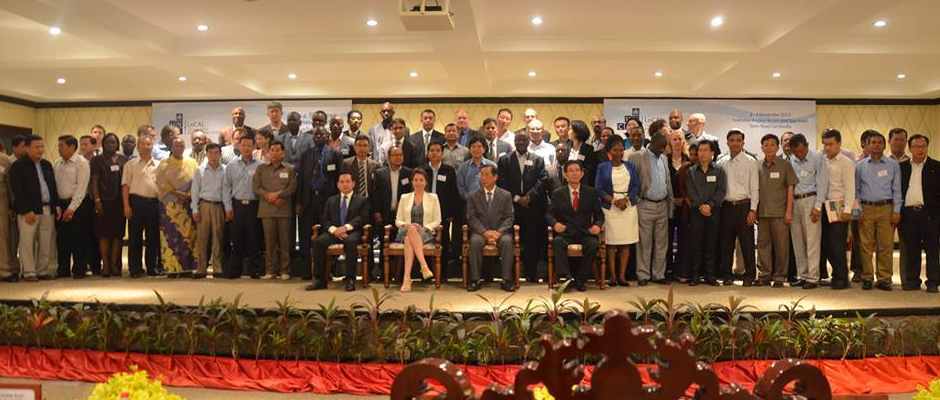
The Local Transformative Finance team at United Nations Capital Development Fund (UNCDF) recently released a book titled Local Government Finance is Development Finance.
This book highlights the partnership, policy and investment agenda of UNCDF in subnational finance. It aims to encourage transformative thinking in support of local sustainable development by examining the current local development finance architecture and by opening discussion about potential innovative new financial instruments and mechanisms at the local levels.
The book argues that the current arrangements are not fit for purpose given the triple challenges of productive livelihoods, urbanization, and climate change and proposes reforms to the financial architecture and investment agenda. Its key message is that there is significant potential to expand the scale of finance at the local level.
The volume is presented as a contribution to the debate and represents the views of the authors and not the United Nations. It is the hope of the authors that this book will serve as an important reference point for local governments and the international community to provide adequate financing at the local level, which is critical for achieving the SDGs by 2030.
UNCDF has a long track record of conceiving and testing innovative financial solutions that mobilize capital investment for their clients – the frontier economies known as least developed countries (LDCs) – and their populations, while contributing to thought leadership for the wider financing of the development agenda. Recent examples of this thought leadership include collaboration with the Organization for Economic Co-operation and Development (OECD) on the annual Blended Finance in the Least Developed Countries report and the biannual World Observatory on Subnational Government Finance and Investment report.
The recently approved UNCDF Strategic Framework 2022–2025 continues this tradition by emphasizing UNCDF’s hybrid nature as a development finance institution on the one hand and a United Nations development agency on the other.
During the discussions leading up to the 2022–2025 Strategic Framework’s approval, Member States and development partners encouraged UNCDF to strengthen its alignment with the priorities of the LDCs as expressed in the Doha Program of Action (2022), which highlights building productive capacity. LDC concerns are also embodied in their collective requests to the Rio conventions on climate, biodiversity and desertification for financial mechanisms that address the existential risks of the environment and climate emergency. And throughout 2021, there was a wider appreciation of the urgency of greater capital flows towards sustainable infrastructure, including local infrastructure, particularly given the rapid growth rate of cities in developing countries. The United Nations Economic and Social Council, with Pakistan in the chair, promoted a focus on sustainable infrastructure finance; and the European Union, together with UN-Habitat, published a landmark report on Financing Sustainable Urban Development.
This publication provides a substantive consideration of one of the questions raised in these debates: Given the scale of the capital flows required, is the architecture of the global financial ecosystem fit for purpose? Much more remains to be done to fully implement the comprehensive framework envisaged in the 2015 Addis Ababa Action Agenda to promote long-term-oriented and transformative investment into the Sustainable Development Goals that is inclusive and sustainable.
Solving this problem will take more than one approach. It will require proactive engagement and energy from multiple actors at different levels of territorial governance. The 2021 report of the Intergovernmental Panel on Climate Change spells out in stark terms the danger to humanity if we ignore the urgent need to act. This necessity compels us to look for imaginative solutions to financing bottlenecks and to rethink the structure of development finance.
Structural changes to the global financial architecture will be required. This publication explores a repurposing of local government finance as a vehicle to accelerate environmentally sustainable and inclusive development.
This book is a thought-provoking, forward-thinking volume in an established tradition of UNCDF ‘outside-the-box’ scholarship. In 1998, Taking Risks highlighted the potential for local development funds to stimulate economic growth and alleviate rural poverty. This approach was a novelty at the time, yet these financing mechanisms have since been taken to scale by governments, development partners and development financial institutions – most notably the World Bank – and have led to a large volume of resources being channeled to the local level.
Similar scale-up resulted from a 2010 discussion note co-authored by UNCDF, the United Nations Development Program and the United Nations Environment Program about local climate finance; this triggered the establishment of the Local Climate Adaptive Living Facility (LoCAL), a standard, internationally recognized country-based mechanism for verifiable climate adaptation finance which is endorsed by both the United Nations Framework Convention on Climate Change and the Doha Program of Action. The LoCAL financing mechanism is currently expanding to 30 countries and is being scaled up by global climate finance.
Another, more recent, visionary work from UNCDF is the 2017 volume on Financing Sustainable Urban Development in the Least Developed Countries; co-authored with the Financing for Sustainable for Development Office (FSDO) of the United Nations Department of Economic and Social Affairs (UN DESA), this publication contributed to the creation of the International Municipal Investment Fund.
Finally, in 2021, UNCDF and FSDO partnered on a pathbreaking UN publication on infrastructure asset management – a hitherto unacknowledged component of development finance.
This volume continues this spirit of innovation and forethought, as a contribution to the wider debate on local sustainable infrastructure financing. It showcases thought leadership and insight from the UNCDF advisors and collaborators in its flagship Local Transformative Finance Practice. Coinciding with the 2022–2025 Strategic Framework, the book provides an analytical tool to align UNCDF initiatives in domestic capital market development, local infrastructure finance, local climate finance, municipal finance and fiscal decentralization with requisite structural reforms to the financial architecture.
Download the full book on the UNCDF website.




